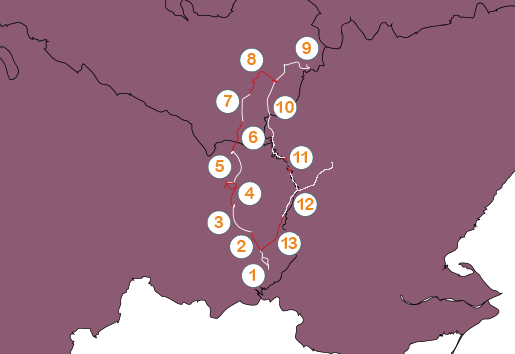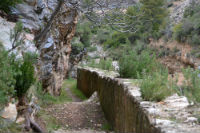- Home
- Rural Development
- Nature Trails
- Nature Trails
- Northeast Sector
- Matarranya Algars
Matarraña-Algars Nature Trail
Description

History, nature and landscapes all accompanied by the rivers Matarraña and Algars.
With a total length of 197 km, the Matarraña-Algars Nature Trail passes through an area which is of great historic and natural interest. With a main itinerary divided into 13 stages, some of which if taken together make up a circular route, plus some detours, this trail goes through the counties of Matarraña/Matarranya (Teruel), Bajo Aragón-Caspe/Baix Aragó-Casp (Zaragoza) and Terra Alta (Tarragona). Mountains, river terraces and towns full of history are just some of the attractions of this route that is recommended for those who love nature and history. Its name has been given thanks to the fact that most of the route is accompanied by the rivers Matarraña and Algars (tributaries of the River Ebro and the River Matarraña respectively).
Select a stage:

At present, a total of 10 stages of the 13 that will make up the Matarraña-Algars Nature Trail have been converted, meaning that more than 155 km of the almost 200 km that the entire trail will comprise of can be walked.
Throughout the different stages of this trail, it is possible to find sheep and bovine livestock. An example of the importance of the sheep livestock in the area is the fact you can find the sheep "Maellana" which take their name from the municipality of Maella. Along with this breed, there are other breeds that can also be highlighted such as the "Aragonese breed" and the "Ojinegra de Teruel", with their characteristic black pigmentation around their eyes, ears and snout. Both of these breeds can be found in great numbers. Others however, such as the "Cartera" breed, just like the Maellana, cannot be found in such numbers and are in danger of extinction. Likewise, and although in the past the bovine presence in the area was greater, it is still possible to find, especially in the first stage, the bovine breed "Serrana de Teruel", whose great hardiness and ability to make the most of scare grazing resources have allowed it to perfectly adapt to the climate and terrain of the massif.
In terms of historic-artistic heritage, the importance of the Iberians in the counties that this nature trail passes through is particularly important. In stages 4.5 and 6, different Iberian settlements can be visited. These make up part of the project "Lower Aragón Iberians", which is of great relevance and quality; they include the Iberian settlements of Torre Cremada, Tozal Montañés and San Cristóbal and the villages of San Antonio and Tozal Redó in Calaceite. Finally, in Mazaleón, the settlements of the Escudines Altes and Baixes can be visited. During stage 10 other important settlements will also be passed through, with the Tozal Moro de Pinyeres, the Roquizal del Rullo, which is considered as the most important Iron Age settlement in Aragón and Punta de la Gessera. Another of the most unique features of heritage along this trail is the Roman mausoleum of Lucius Amilius Lupus. Located in the municipality of Fabara, this is perhaps the most well preserved monument of its type on the Iberian Peninsula.
On the alternative route from stage 4, which passes through the Iberian settlements, the itinerary connects with the Val de Zafán Nature Trail, which passes through Teruel along the old railway platform that linked Tortosa (Tarragona) with Puebla de Híjar (Teruel) and that stopped working in 1973. From stage 12, specifically from the former train station of Arnes - Lledó, the aforementioned Nature Trail can be accessed, also from there, another section of this dismantled railway that had been conditioned as Terra Alta Natural Trail can be reached. The latter Nature Trail can be accessed also from the branch in stage 12 that leads to Horta de Sant Joan station
From stage 9, stage 36.1 of the Ebro Nature Trail can be reached. This passes through land that is bathed by the river that is so important in the Iberian Peninsula, from its beginning in Fontibre (Cantabria) to its mouth in the province of Tarragona. One of the stages of the Jacobeo del Ebro Trail, an alternative to the Camino de Santiago, crosses through this Nature Trail on no less than two occasions, specifically in stage 6 which links Caspe and Fabara..
